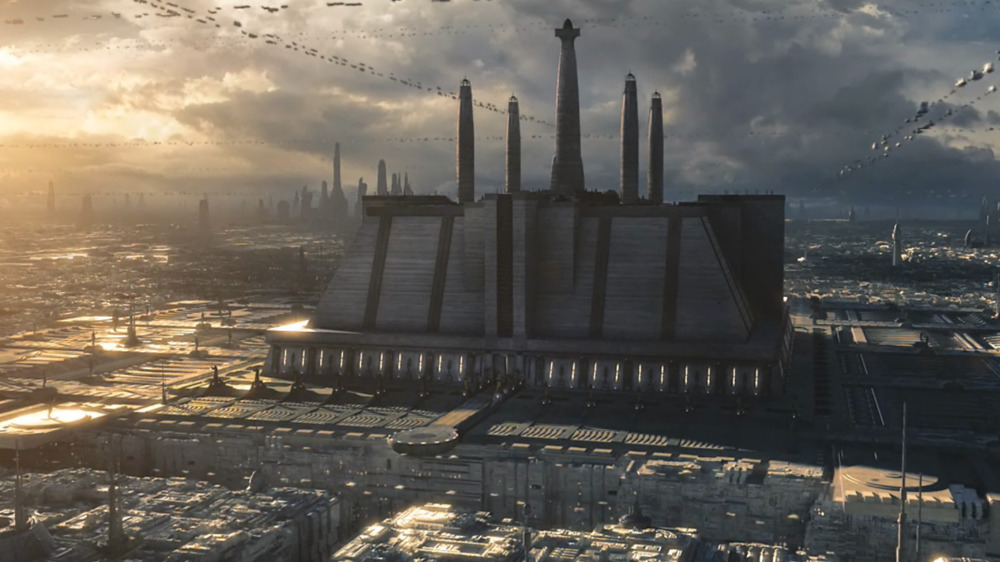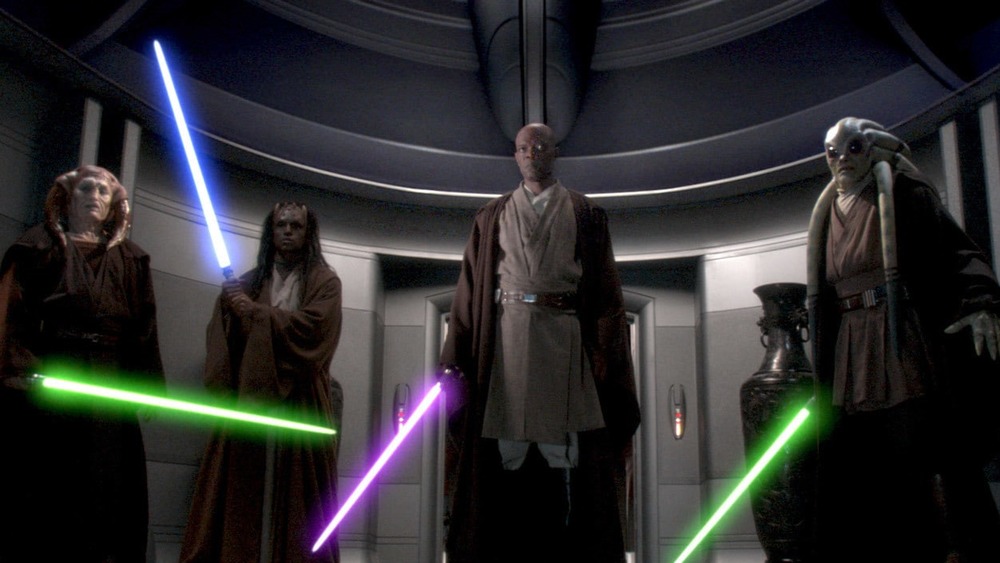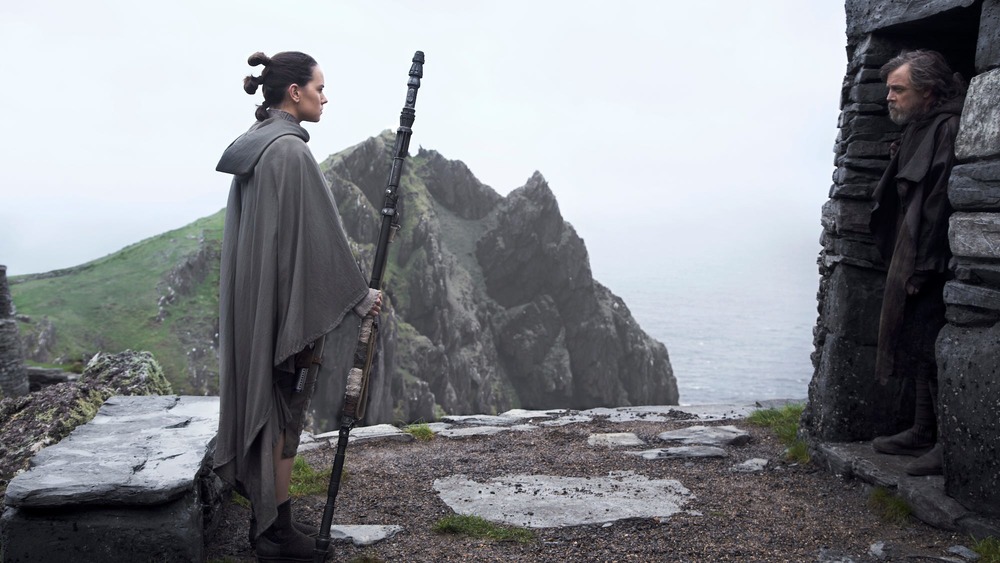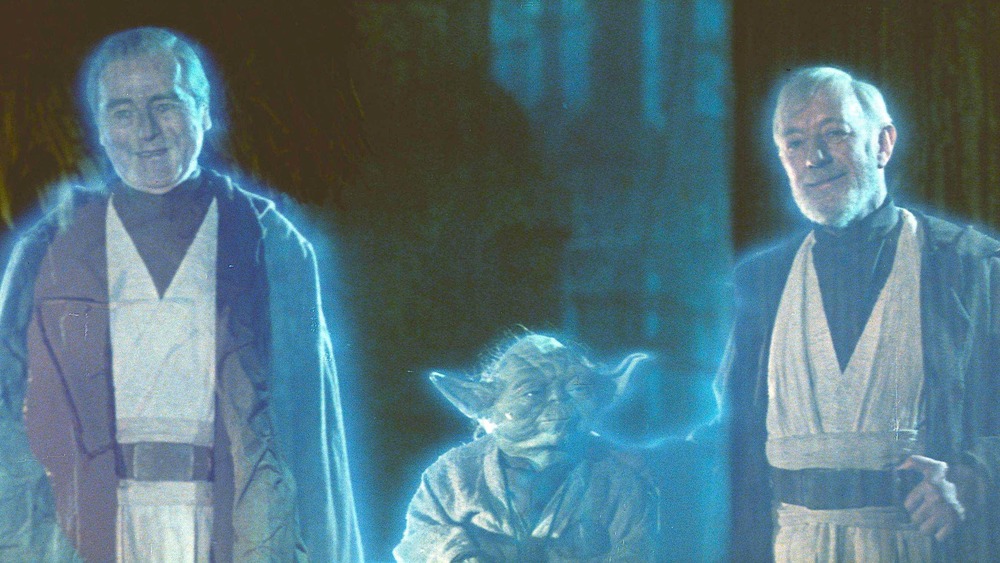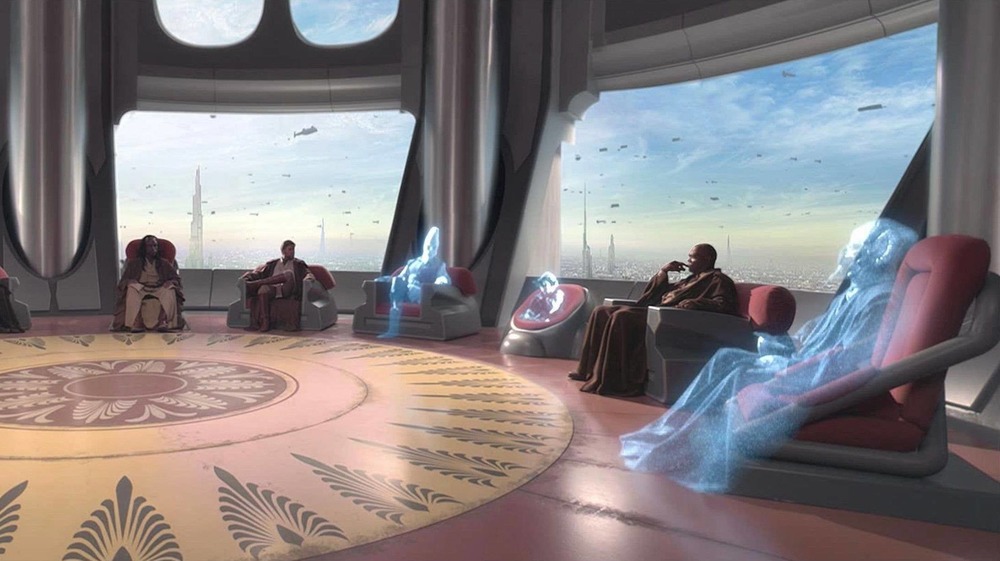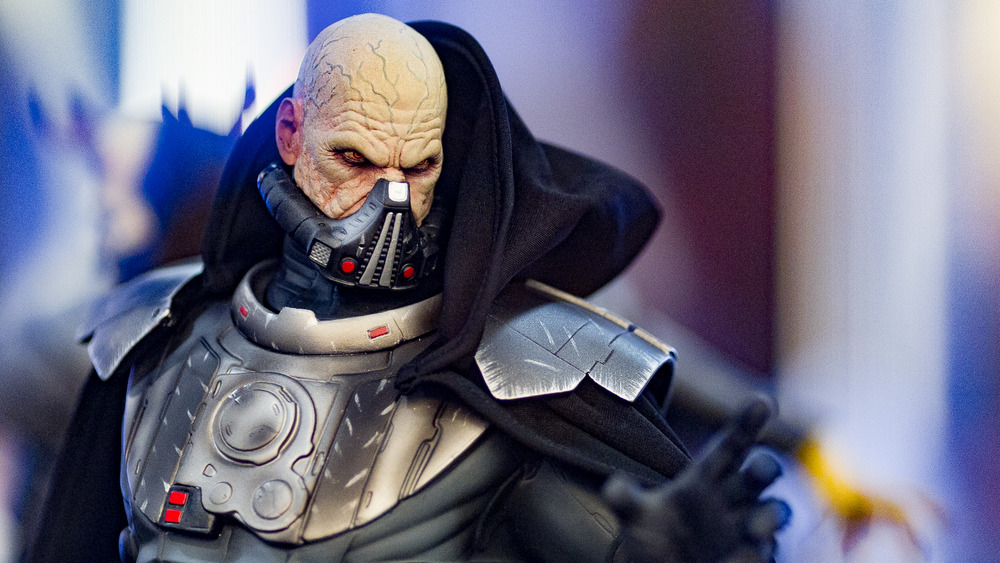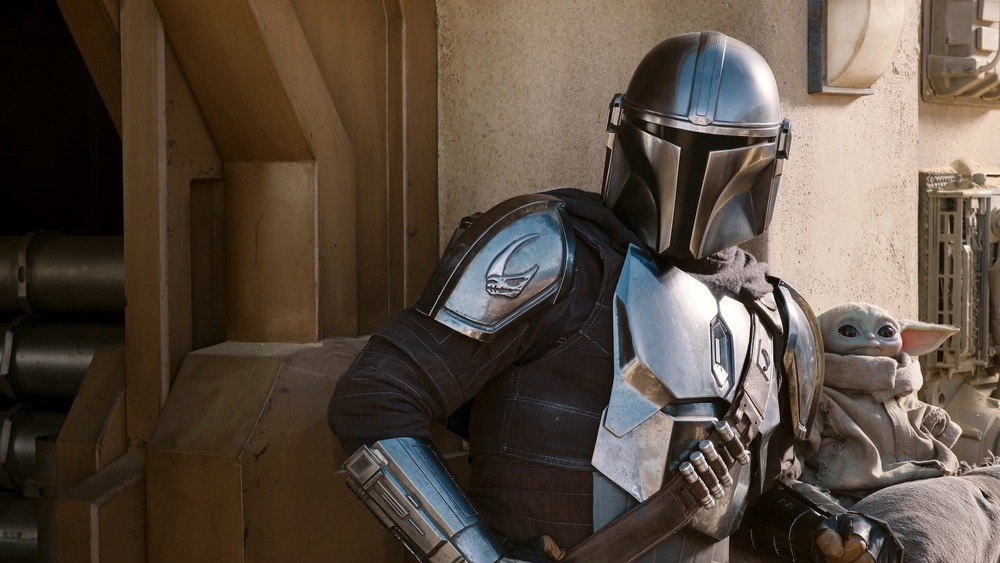Everything You Need To Know About Jedi Temples
The world of Star Wars – that galaxy far, far away — is big enough to handle just about any premise you want to throw at it. The Star Wars expanded universe can carry as many potential theories, reads and lenses that fans can generate. If you want to view it as a samurai story told across endless expanses, you can. If you want to call it a soap opera in space, you can. If you want to read it as a galactic drama blowing up the internal struggle to be good to massive proportions, you can.
Even though dueling religions are at the heart of the saga, one possible read that rarely gets trotted out is the history of holy wars. The Jedi and Sith beat each other back in the hopes of controlling the known universe and the Star Wars story becomes an analogue for our own world's religious skirmishes. Jedi and Sith temples stake out planets as outposts of the supposed one true path of the force, acting as fortresses in a cosmic crusade.
Throughout the series, the temples are used as great symbols of the Jedi and Sith's fortunes, acting as a stand-in for their order's strength or weakness at any given time. A Jedi temple in ruins can show readers everything they need to know quickly, and the sacking of a temple makes for great drama.
An ancient order
With the temples popping back up in recent episodes of The Mandalorian, we have the time to talk about them as more than a prop. Over decades of television, movies and books, the temples have gained quite a bit of interesting history for writers to play with (as the Star Wars universe expands exponentially outward). It's worth taking a look as the series heads to Tython. But before we can talk temples, we have to understand the Jedi.
The Jedi are an ancient order of mystical warrior knights, who believe in a peaceful balance to the universe above all else. The Jedi gain incredible powers by using calm and inner peace to access the connective energy of the universe (known as "the Force"). Because of their commitment to — and dependence on — the balance of the universe, the Jedi became peacekeepers throughout the galaxy. For nearly 25,000 years, the Jedi served as guardians of law and order in the original Galactic Republic.
There is a flip side to the Jedi belief system, however. The Force can also be accessed via methods of hatred and anger and wielded as a brutal weapon in the name of dominating the universe. This path was founded by a disgruntled former Jedi who saw no use in leaving the universe as it was and its followers were known as Sith.
The first temples
A religion isn't much without monuments. The worldly need places to observe their connection to something greater, even knights who espouse a connection to every cell of every living thing in the universe.
The very first Jedi temple was built on the far-flung planet of Ahch-To. The watery planet is made up of several islands and believed to be the origin of the Jedi religion. The first place of worship for the Force followers is hidden away on one such island.
Though it was the origin point of the entire Jedi faith, the temple on Ahch-To fell into disrepair for unknown reasons. It was not destroyed in the centuries of war between the Jedi and other faiths. The temple was mysteriously abandoned well before the entire Jedi Order was laid low by the Galactic Empire.
After the fall of the Empire and the eventual rise of the First Order, Luke Skywalker uses the temple as a place of refuge. The disillusioned Jedi returns to the source of his faith after his apprentice Kylo Ren falls to the Sith and becomes a high-ranking official with the fascist rivals of the Jedi Order.
A beacon for all Jedi
As evidenced by its state of decay, the first Jedi Temple at Ahch-To did not become the center of the Jedi Order. That place would come to exist on Coruscant. The Jedi were granted the opportunity to build on the planet's central mountain and construction began under the Old Republic, about 5,000 years before the formation of the Galactic Empire. The local government of Coruscant hoped to gain the protection of the Jedi, eyeing for their mountain a fortress like the ones the Order had built on other planets.
The space was sacred to the locals and recognized by Jedi and Coruscanti alike as a place of great power. The original Jedi who were granted the land seemed to recognize this and kept their presence on the holy mountain small.
As the Order grew in power and numbers, these spires were connected by further buildings. The result of the continued growth was a palatial and labyrinthine complex with contrasting architectural styles within and easily recognizable minarets around the outside.
War forces consolidation
The Jedi were eventually forced to build a defensible fortress on the sacred site. The Order needed a place of refuge for their cast-about knights after several other Jedi temples were destroyed in the collection of conflicts dubbed the Old Sith Wars. The Jedi Temple on Coruscant became the home of the majority of Jedi knowledge and sacred texts after their former library planet Ossus was destroyed by a supernova initiated by powerful Sith lords.
Salvaged texts and art were added on to the temple as it grew into its ziggurat form. The gathering of Jedi masters and the sum of Jedi knowledge in the rapidly growing building led to logical next steps. The training academies for children looking to become Jedi Knights and the high councils made up of the most senior members of the Order migrated to the Coruscant temple as it continued to grow.
Home of the Jedi administration
The films of the Star Wars universe frequently referred to the Jedi Council and showed that to be the panel led by Yoda. You might take from this that there was only one council of knights in the Jedi Temple on Coruscant. This is as false as the assumption that the Coruscant temple was the only place of worship for the ancient warrior-religion.
There were actually several Jedi councils who held court in the signature spires of the Jedi temple. In the same manner of the temple's sprawling architecture, the administration of the Jedi Order had a way of spreading outward. As the temple grew, so too did the many functions carried out within it. The Jedi Temple on Coruscant was the new Great Library, the capitol building of the Order, a fortress for Jedi to gather in times of crisis and, of course, a holy site.
The central spire of the temple (dubbed the Tranquility Spire) was built on the summit of the holy mountain and was used as a meditative space for the highest ranking Jedi. The temple served as an embassy of the Jedi Order, with a section dedicated to visitors and the public. The Jedi Service Corps, a sort of Peace Corps for the Jedi Order, was housed within the temple.
Surprisingly vulnerable
In spite of its seeming impenetrability, the main Jedi Temple on Coruscant has been sacked, robbed and otherwise defiled many times. Under the old Republic, the temple was largely destroyed by an attack on Coruscant from the Sith Lord Darth Malgus.
Malgus' forces killed the Temple guards and planted bombs inside the walls of the millennia-old fortress. As the bombs exploded, Sith aircraft rained down gunfire from above. The four outer spires fell, while the core spire and its interior temple remained standing. The temple was not rebuilt for many years after, as the Order and Coruscant lacked the funds. The Jedi temple was eventually restored after the Sith Empire was defeated.
The end of the Sith Empire ushered in thousands of years of peace. Once the dark Force users returned to the universe, however, the temple became a target. It was the site of many failed raids, terrorist attacks and robberies before the Clone Wars erupted. The Jedi Temple was destroyed again near the end of that conflict, due to a raid led by fallen Jedi Anakin Skywalker. The raid on the temple and the Jedi Purge throughout the galaxy left the temple abandoned for many years. It would not be rebuilt until the Empire was driven from Coruscant by the New Jedi Order.
The sites have special meaning
The conflicts at the heart of Star Wars play out over thousands of years. The Jedi are locked in an eternal holy war with the Sith. Their temples come to symbolize this as often as not.
More than just being a planted flag marking a territory as one under the protection of the Jedi Order, the temples act to cleanse Sith energy wherever they are built. Jedi temples are occasionally built on the site of former Sith shrines, in the hopes of curtailing that dark Force energy and redirecting it in the Jedi's preferred manner of peace.
This is true of the Jedi's most famous temple. The Jedi Temple on Coruscant was built on the ruins of a Sith shrine. The Sith had built on the site in the hopes of corrupting the light Force energy that was present on the mountaintop. The Sith order managed this corruption and the original Jedi temple built on the mountaintop was partially constructed to try and fix this. The Jedi hoped that having many Jedi adepts worshipping atop the dark Force fount would push it back toward the light side of things. Dark energy still exists within the temple for people who are seeking it out, though.
"The Jedi tried to cap the power of this shrine, but there's leakage. It's not just Sidious; it's the power of history, it's the residue of what's left of the dark side there," author James Luceno explained.
Even older than we thought
The events of The Mandalorian have revived temples even older than the one on Ahch-To. After Disney burned the Star Wars expanded universe to the ground, fans made up for the dissonance by splitting the lore in two. The canon referred to accepted stories under Disney's stewardship. Unaccepted stories that were part of the old universe came to be called legends. The writers of The Mandolorian are clearly students of some of those legends, as they brought back the planet of Tython.
Tython was the home of the Je'Daii, an even older order of mystics that would become the Jedi. Tython was the home of a massive pyramid that mysteriously attracted Force-sensitive people in the Deep Core of the Star Wars galaxy. The people that would become the Je'Daii were transported to this pyramid from temples around the galaxy. Once on the planet, they learned the intricacies of the Force and how to wield it. While the Je'Daii were initially open to using both sides of the Force, the confusion and arguments this caused eventually grew into a civil war. After the light-side Force users prevailed, the Je'Daii became strict light-side adepts. This laid the groundwork for the Jedi and Sith of later years.
